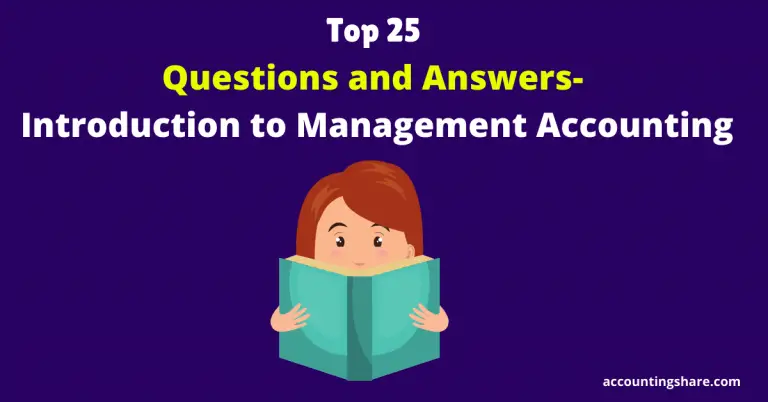Top 25 Questions and Answers- Accounts [Notes with PDF]
Today, we will learn the Top 25 Questions and Answers-Accounts. If you read it from top to bottom with a proper emphasis, you’ll get a basic idea of the accounts.
It will also enhance your accounting knowledge and help you do well on any competitive test.
So let’s get started.
Questions and Answers- Accounts
Question-01: What is an account?
Answer: An account is a summary record of all transactions relating to a particular account, institution, property, income, or expenditure arranged by accounting rules under an appropriate heading.
Question-02: What is the necessity of recording accounts?
Answer: The necessity of recording accounts are as follows:
- Determining Cash Balance
- Application of double entry system
- Justify arithmetical accuracy of accounts
- Determining Financial position
- Aid to prepare financial statement.
- Helping in assessing tax.
Question-03: How many types of accounts tables are used in accounting? And what are they?
Answer: Two types of accounts tables are used in accounting. Which are as follows:
- T-Table
- Moving Balance Table
Question-04: What are the features of the “T “Table?
Answer: The features of the “T “table are
- There will be an account title,
- The table has two sections: Debit & Credit.
- Four columns out of eight columns on both sides
- Accounts should calculate the balance of accounts (the difference between total debit and total credit) after a specific period interval.
- Each account should have a code number.
Question-05: What are the features of the Moving Balance Table?
Answer: The features of the “Moving Balance “table are
- There will be an account title,
- Each account should have a code number.
- For date, description & journal folio (J.F.), one column each.
- It has four columns in total for the amount.
- Debit & credit amount column, side by side,
- It calculates the balance of accounts after posting each transaction.
Question-06: How many methods are there for the classification of accounts? And what are they?
Answer: There are two methods for the classification of accounts. Which are as follows:
- Traditional Method and
- Modern or Equation Method.
Question-07: What are the advantages of the classification of accounts?
Answer: The advantages of classification of accounts areas:
- After the account classification, It is effortless to determine the debit and credit aspects of transactions.
- It is easy to calculate the accounting unit’s financial results (i.e. income & expenditure or trading and profit & loss accounts).
Question-08: What is the format of the account?
Answer: The format which is used to record by summarizing the same class of transactions under the appropriate heading is called the format of the account.
Question-09: What is a personal account?
Answer: An account relating to a person or institution is called a personal account—for example, Harry A/C, Potter A/C, ABC International A/C, etc.
Question-10: How many types of personal accounts are there, and what are they?
Answer: There are two (2) types of personal accounts. Which are as follows:
- Debtors Account and
- Creditors Account
Question-11: What is Debtor Account?
Answer: The personal accounts from whom the concern or accounting units are entitled to receive money are called debtor account.
Question-12: What is a creditor account?
Answer: The personal accounts to whom money is to be paid by the concern or accounting unit are called creditor account.
Question-13: What is an impersonal account?
Answer: An account that does not relate to any person or institution, but rather to a property, income, or expenditure is called an impersonal account—for example, Machinery A/C, Salary A/C, Commission A/C, etc.
Question-14: What is a real or property account?
Answer: An account relating to a property is called a real or property account—for example, Land A/C, Building A/C, Furniture A/C, etc.
Question-15: What is the nominal account?
Answer: An account relating to an income or expenditure is called a nominal account—for example, Salary A/C, Discount Allowed A/C, etc.
Question-16: What is an asset account?
Answer: The account kept in classifying the transactions for which the assets increase or decrease is called an asset account—for example, Bank A/C, Cash A/C, Building A/C, etc.
Question-17: What is a liability account?
Answer: The account kept classifying the transactions for which liability increases or decreases is called liability account. For example, Accounts Payable A/C, Capital A/C, Loan A/C, etc.
Question-18: What is an expenditure account?
Answer: The account kept under different heads classifying the various expenditures of a business or institution is called an expenditure Account—for Example, Wages A/C, Purchase A/C, Gas Bill A/C, etc.
Question-19: What is an income account?
Answer: The accounts kept under different heads having classified the transactions relating to income properly, are called income account. For Example, Sales A/C, Commission Received A/c, Service Revenue A/C, etc.
Question-20: What is the owner’s equity account?
Answer: Owners equity means owner claim over assets. The account which represents the owner’s claim is called the owners’ equity account.
Question-21: What is the full form of Dr. and Cr.?
Answer:
Dr. = Debit
Cr. = Credit
Question-22: What is debit?
Answer: When the value comes in, or the asset increases are called a debit.
Question-23: What is Credit?
Answer: When the value goes out, or the asset decreases is called credit.
Question-24: What is Balance?
Answer: The difference between the total amount of debit and credit of an account is called balance.
Question-25: What is the balancing of the account?
Answer: Balancing of the account is the process of finding the balance between the debit and credit sides of an account at the end of a specific period.
I hope you understand the concepts of the accounts at the end of the article. Read these Top “25” Questions and Answers- Accounts regularly and strengths your accounting skill.
You can also read:







